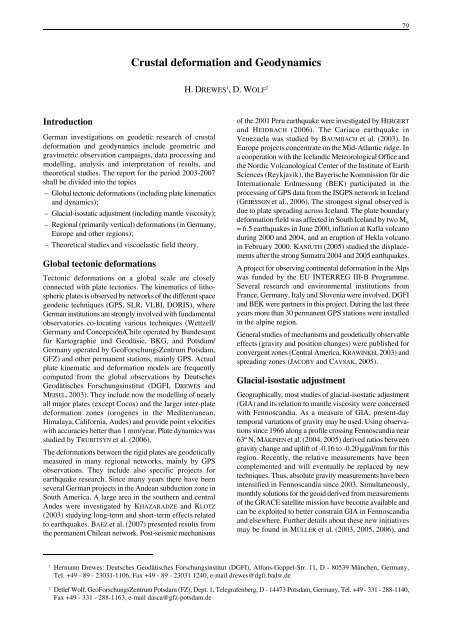NATIONAL REPORT OF THE FEDERAL REPUBLIC OF ... - IAG Office
NATIONAL REPORT OF THE FEDERAL REPUBLIC OF ... - IAG Office
NATIONAL REPORT OF THE FEDERAL REPUBLIC OF ... - IAG Office
Create successful ePaper yourself
Turn your PDF publications into a flip-book with our unique Google optimized e-Paper software.
Introduction<br />
German investigations on geodetic research of crustal<br />
deformation and geodynamics include geometric and<br />
gravimetric observation campaigns, data processing and<br />
modelling, analysis and interpretation of results, and<br />
theoretical studies. The report for the period 2003-2007<br />
shall be divided into the topics<br />
– Global tectonic deformations (including plate kinematics<br />
and dynamics);<br />
– Glacial-isostatic adjustment (including mantle viscosity);<br />
– Regional (primarily vertical) deformations (in Germany,<br />
Europe and other regions);<br />
– Theoretical studies and viscoelastic field theory.<br />
Global tectonic deformations<br />
Tectonic deformations on a global scale are closely<br />
connected with plate tectonics. The kinematics of lithospheric<br />
plates is observed by networks of the different space<br />
geodetic techniques (GPS, SLR, VLBI, DORIS), where<br />
German institutions are strongly involved with fundamental<br />
observatories co-locating various techniques (Wettzell/<br />
Germany and Concepción/Chile operated by Bundesamt<br />
für Kartographie und Geodäsie, BKG, and Potsdam/<br />
Germany operated by GeoForschungsZentrum Potsdam,<br />
GFZ) and other permanent stations, mainly GPS. Actual<br />
plate kinematic and deformation models are frequently<br />
computed from the global observations by Deutsches<br />
Geodätisches Forschungsinstitut (DGFI, DREWES and<br />
MEISEL, 2003). They include now the modelling of nearly<br />
all major plates (except Cocos) and the larger inter-plate<br />
deformation zones (orogenes in the Mediterranean,<br />
Himalaya, California, Andes) and provide point velocities<br />
with accuracies better than 1 mm/year. Plate dynamics was<br />
studied by TRUBITSYN et al. (2006).<br />
The deformations between the rigid plates are geodetically<br />
measured in many regional networks, mainly by GPS<br />
observations. They include also specific projects for<br />
earthquake research. Since many years there have been<br />
several German projects in the Andean subduction zone in<br />
South America. A large area in the southern and central<br />
Andes were investigated by KHAZARADZE and KLOTZ<br />
(2003) studying long-term and short-term effects related<br />
to earthquakes. BAEZ et al. (2007) presented results from<br />
the permanent Chilean network. Post-seismic mechanisms<br />
Crustal deformation and Geodynamics<br />
H. DREWES 1 , D. WOLF 2<br />
1 Hermann Drewes: Deutsches Geodätisches Forschungsinstitut (DGFI), Alfons-Goppel-Str. 11, D - 80539 München, Germany,<br />
Tel. +49 - 89 - 23031-1106, Fax +49 - 89 - 23031 1240, e-mail drewes@dgfi.badw.de<br />
2 Detlef Wolf, GeoForschungsZentrum Potsdam (FZ), Dept. 1, Telegrafenberg, D - 14473 Potsdam, Germany, Tel. +49 - 331 - 288-1140,<br />
Fax +49 - 331 - 288-1163, e-mail dasca@gfz-potsdam.de<br />
79<br />
of the 2001 Peru earthquake were investigated by HERGERT<br />
and HEIDBACH (2006). The Cariaco earthquake in<br />
Venezuela was studied by BAUMBACH et al. (2003). In<br />
Europe projects concentrate on the Mid-Atlantic ridge. In<br />
a cooperation with the Icelandic Meteorological <strong>Office</strong> and<br />
the Nordic Volcanological Center of the Institute of Earth<br />
Sciences (Reykjavik), the Bayerische Kommission für die<br />
Internationale Erdmessung (BEK) participated in the<br />
processing of GPS data from the ISGPS network in Iceland<br />
(GEIRSSON et al., 2006). The strongest signal observed is<br />
due to plate spreading across Iceland. The plate boundary<br />
deformation field was affected in South Iceland by two Mw = 6.5 earthquakes in June 2000, inflation at Kafla volcano<br />
during 2000 and 2004, and an eruption of Hekla volcano<br />
in February 2000. KANIUTH (2005) studied the displacements<br />
after the strong Sumatra 2004 and 2005 earthquakes.<br />
A project for observing continental deformation in the Alps<br />
was funded by the EU INTERREG III-B Programme.<br />
Several research and environmental institutions from<br />
France, Germany, Italy and Slovenia were involved. DGFI<br />
and BEK were partners in this project. During the last three<br />
years more than 30 permanent GPS stations were installed<br />
in the alpine region.<br />
General studies of mechanisms and geodetically observable<br />
effects (gravity and position changes) were published for<br />
convergent zones (Central America, KRAWINKEL 2003) and<br />
spreading zones (JACOBY and CAVSAK, 2005).<br />
Glacial-isostatic adjustment<br />
Geographically, most studies of glacial-isostatic adjustment<br />
(GIA) and its relation to mantle viscosity were concerned<br />
with Fennoscandia. As a measure of GIA, present-day<br />
temporal variations of gravity may be used. Using observations<br />
since 1966 along a profile crossing Fennoscandia near<br />
63º N, MÄKINEN et al. (2004, 2005) derived ratios between<br />
gravity change and uplift of -0.16 to -0.20 :gal/mm for this<br />
region. Recently, the relative measurements have been<br />
complemented and will eventually be replaced by new<br />
techniques. Thus, absolute gravity measurements have been<br />
intensified in Fennoscandia since 2003. Simultaneously,<br />
monthly solutions for the geoid derived from measurements<br />
of the GRACE satellite mission have become available and<br />
can be exploited to better constrain GIA in Fennoscandia<br />
and elsewhere. Further details about these new initiatives<br />
may be found in MÜLLER et al. (2003, 2005, 2006), and











